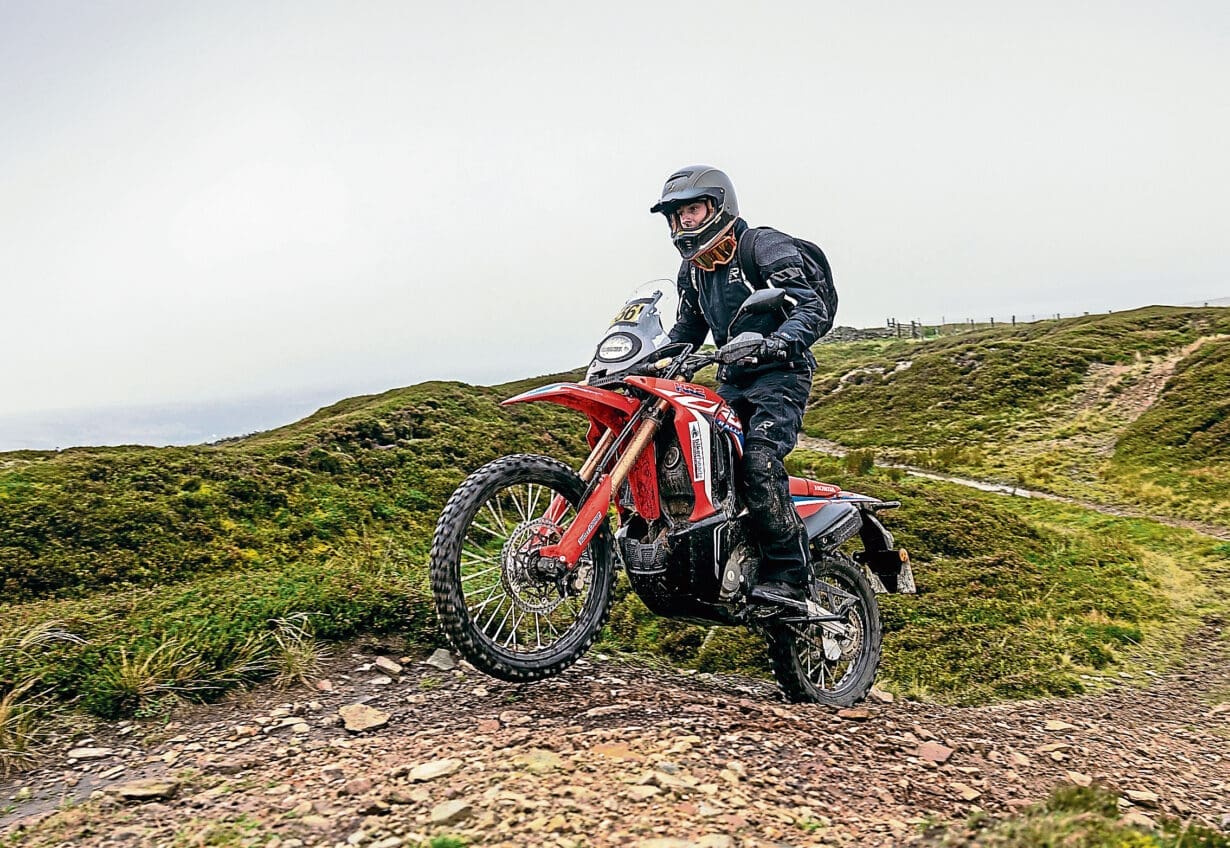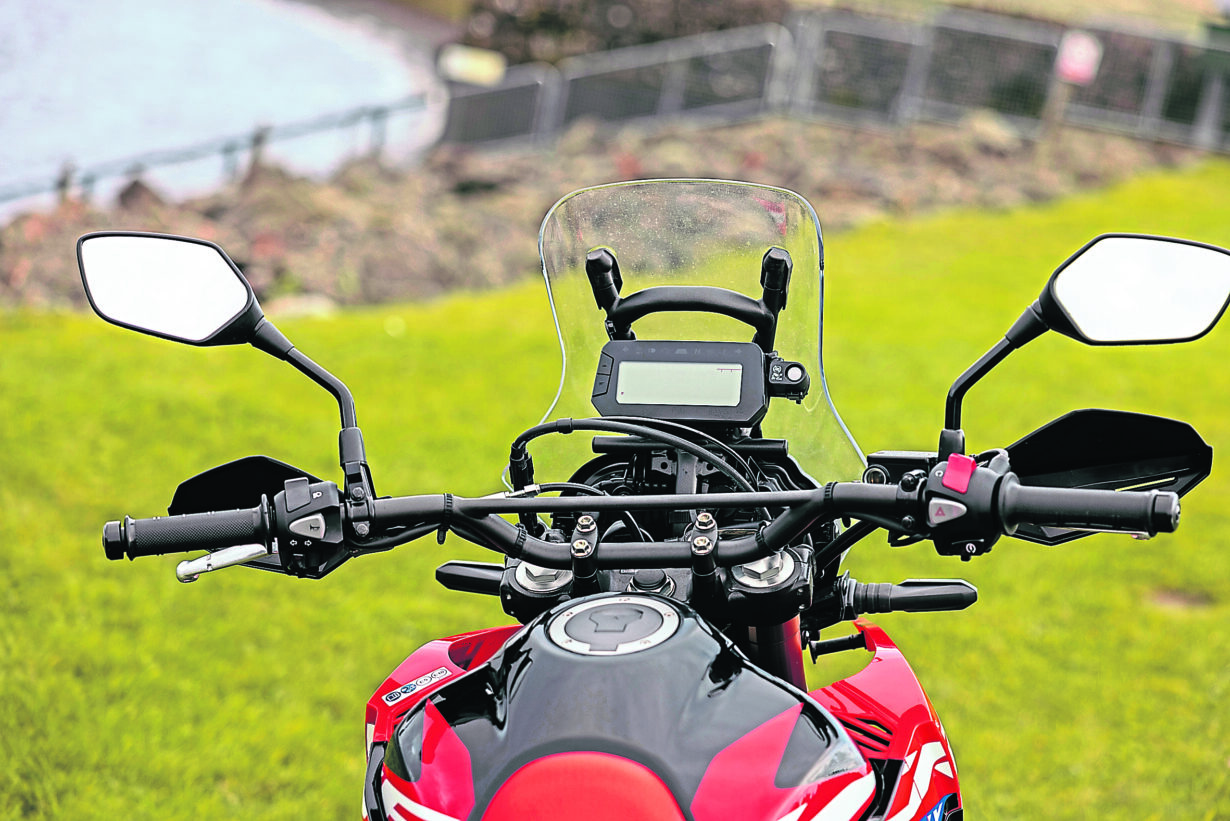Chris Moss runs the rule over the CRF and editor Ross gives his verdict:
I’d had to wait until the end of the first day to get on the Honda, but the timing turned out to be perfect. Darkening skies, with rain imminent, meant the prospect of riding the last 80-mile leg to the hotel wasn’t exactly thrilling. But from very early on, I warmed to the 300. Only having ridden the L version before had me appreciate the Rally’s bigger tank, and its fairing and screen felt heaven-sent. The most expensive bike of the four might have some minor shortcomings, but for this trip and most of the time I spent on it afterwards, the Honda drew plenty of praise from me. By the time I parked it up at the end of the test, I paid it the ultimate compliment. More of that later.
That first ride, essentially just a must-do trip from A to B, might well have been ridden in far from ideal circumstances, but it still showed the Honda in a very good light. It’s clearly the product of lots of careful thought and design. The riding position feels spot on; the controls are light and easy; there’s plenty of useful instrumentation; it feels really comfy, relaxed, friendly, and manageable; and sips fuel at a miserly rate. It’s actually quite hard to knock.

Of course, realistic assessment of the Honda and putting its performance into context is important. This is a relatively simple, basic bike with modest power and speed. Yet when you ride it, you quickly learn it’s much more than the sum of its parts. As with most bikes, the engine plays an influential role, with the small-capacity single providing soft, friendly, but more often than not, prompt throttle response to make gear changing less obligatory than you might expect. It may well only produce a maximum of just 27bhp, but adjust your speed expectations and routes, and the Honda can feel sufficiently nippy.
It felt a little at the mercy of the faster traffic on the dual carriageways I used to begin with, but if you find a group of vehicles travelling at the right speed to fit into, all feels well enough. Seeing a claimed 90mpg on the dash more than compensated for the steady 50-60mph I ended up progressing at.
“Maybe the positive verdict on the Honda shouldn’t come as a surprise. The biggest bike builder in the world has a habit of often getting things right…”
On bigger A-roads, you still need to keep your eyes on the mirrors for the faster traffic, and your own overtakes need to be assessed carefully, often requiring a significant speed advantage to be completed swiftly and safely. Without that, it’s a case of knowing your place and sitting in line. Even so, I still ended what had been a long day feeling comfortable and fresh enough, appreciating the Honda had been a great ally, reducing the burden of what could have easily felt like a very tedious trip. The more interesting, rewarding riding came the next day.
On the official N250 route, along some of the slower sections, the 300’s flexible, friendly nature has it fit in nicely. Handling better than you might think (a static test of the longer travel forks and shock has you expecting they’ll both be much too soft to cope), the CRF covers ground more than competently. Even if the ground is uneven and rutted, as it was on many of the off-road sections, the control is surprisingly acceptable. I didn’t ride it much on the dirt, but I witnessed both Gary and Ross doing a good job for long enough to judge it as capable. Besides, I’ve also done enough miles on the L version of the bike to know how well it cuts the mustard on the rough stuff.
Riding the 300 swiftly on the road doesn’t faze it either. There’s a bit of dive from the forks if you use the capable brakes harder, though that’s more of a reflection on the softness of the suspension than the power of the stoppers. But all in all, the combination works very well, and being able to switch off the rear ABS helps on the dirt.

Maybe the positive verdict on the Honda shouldn’t come as a surprise. The biggest bike builder in the world has a habit of often getting things right, and unsurprisingly both the L and Rally versions of the 300 are big sellers. Allied to the CRF’s reputation for reliability and good dealer back-up, its solid-looking build quality, and the overall sorted and user-friendly feel so typical of the brand, the Honda turned out to be everyone’s favourite of the bunch.
Personally, I like it so much I’d consider buying one. It might be short of power, and lacking a little in personality, but as a budget all-rounder/dual-purpose bike, it ticks many boxes and scores very highly.
Ross’ opinion
The CRF’s a brilliant motorcycle. I’ve spent a good chunk of time on previous and current generations, and the near-bulletproof, go-anywhere trail bike still made me smile every time I managed to nab the keys. It’s the benchmark in this category – not because it’s the best at any one thing, but because it’s so easy to ride, easy to live with and easy to trust. It might not offer quite enough potency for ‘serious’ off-road riders and the suspension’s very soft as standard, but no matter whether you want to explore your local lanes or cross continents, the Honda’s a solid choice. I’d have one.
Tech spec
Honda CRF300 Rally
Price: £6599
Engine: 286cc, liquid-cooled, 4v, DOHC, single
Power: 27bhp (20Kw) @ 8500rpm
Torque: 26.6Nm (20lb-ft) @ 6500rpm
Transmission: Six-speed, chain drive
Frame: Steel semi double-cradle
Suspension: (F) 43mm inverted forks, no adjustment, (R) rising-rate monoshock, adjustable preload
Brakes: (F) 296mm disc, twin-piston ABS caliper, (R) 220mm disc, single-piston ABS caliper
Wheels/Tyres: (F): 80/100-21 (R): 120/80-18
Seat height: 885mm
Wheelbase: 1455mm
Kerb weight: 153kg
Fuel capacity: 12.8 litres
Fuel consumption: 90mpg (claimed)
Warranty: 2 years, unlimited mileage
Service intervals: 8000 miles / 12 months
Contact: www.honda.co.uk


